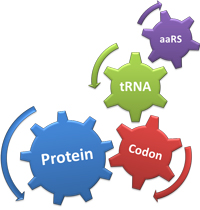Team:SJTU-BioX-Shanghai
From 2011.igem.org
| Line 1: | Line 1: | ||
{{Template:11SJTU_header}} | {{Template:11SJTU_header}} | ||
| - | <html> | + | {{Template:11SJTU_Nav}} |
| + | <html> | ||
<head> | <head> | ||
| - | <style> | + | <style> |
| + | p{text-indent:2em; text-align:justify;} | ||
| + | div#container{ float:left; width:967px; background:#fff; } | ||
| + | div#side{float:left; width:240px; background:#eee;height:1000px;border-right: 2px solid #fff; } | ||
| + | div#swf{float:right; width:660px;height:400px; margin:20px 40px 0 0; } | ||
| + | div#dtl{float:right; width:660px;margin:10px 40px 0 0; } | ||
| + | .title{ padding:10px ;margin:0;height:40px;} | ||
| - | + | div#pro{float:left;padding:0 10px 10px 10px;border:1px dashed #fabd28;height:350px;} | |
| - | + | ||
| + | div .box{float:left; margin:10px; width:300px; height:300px; border:1px dashed #fabd28;} | ||
| + | div .t{ padding:10px ;margin:0;height:90px;width:90px;} | ||
| + | </style> | ||
| + | </head> | ||
| + | <body> | ||
| + | <div id=container> | ||
| + | <div id="side"> | ||
| + | </div> | ||
| + | <div id=swf> | ||
| + | <embed src="/wiki/images/1/18/11SJTU-home.swf" wmode="transparent" height="380 px" width="660 px" > </embed> | ||
| + | </div> | ||
| - | div | + | <div id="dtl"> |
| - | + | <div class="title"><b>The Project: Condon Switch Controlling Protein Biosynthesis</b></div> | |
| - | + | <div id="pro"> | |
| - | + | <p>SJTU-BioX-Shanghai iGEM team is designing a modulating device that achieves fine tuning of target protein biosynthesis (translation). </p> | |
| - | + | ||
| - | + | <p>The translation of the protein can be finely turned up/down with the control of the number of rare codons and the different strength of tRNA induction.</p> | |
| - | + | ||
| - | + | ||
| - | + | ||
| - | + | ||
| - | + | ||
| - | + | ||
| - | + | ||
| - | + | ||
| - | + | ||
| - | + | ||
| - | + | ||
| - | + | <p>Besides, our device can be made into a real switch that can be turned on/off without background protein expression in two ways. One is to use any codon but initial codons to initiate translation, the other is to use stop codon as the controlling element. | |
| - | + | <img src="/wiki/images/e/e2/11SJTU_home_fig1.jpg" alt="Project" style="float:right;"/></p> | |
| - | + | ||
| - | + | ||
| - | + | ||
| - | + | ||
| - | + | ||
| - | + | ||
| - | + | ||
| - | + | ||
| - | + | ||
| - | + | ||
| - | + | ||
| - | + | ||
| - | + | ||
| - | + | ||
| - | + | ||
| - | + | ||
| - | + | ||
| - | + | ||
| - | + | ||
| - | + | ||
| - | </ | + | |
| - | < | + | <p>Moreover, our design would be a brand-new way to selectively express part of a gene or introduce point mutations into target residues in proteins, thus favoring the study of the important domains or residues of a target protein. |
| - | < | + | </p> |
| - | + | ||
| - | < | + | <a href="/wiki/Team:SJTU-BioX-Shanghai/Project">>>Goto Project</a> |
| - | + | ||
</div> | </div> | ||
| - | <div class=" | + | <div class="box"><div class="t"><b>Team</b></div></div> |
| - | + | <div class="box"><div class="t"><b>Parts</b></div></div> | |
| - | </div> | + | <div class="box"><div class="t"><b>Notebook</b></div></div> |
| + | <div class="box"><div class="t"><b>Human Practice</b></div></div> | ||
| - | |||
| - | |||
| - | |||
| - | |||
| - | |||
| - | |||
| - | |||
| - | |||
| - | |||
| - | |||
| - | |||
| - | |||
| - | |||
| - | |||
| - | |||
| - | |||
| - | |||
| - | |||
| - | |||
| - | |||
| - | |||
</div> | </div> | ||
Revision as of 15:34, 3 October 2011
SJTU-BioX-Shanghai iGEM team is designing a modulating device that achieves fine tuning of target protein biosynthesis (translation).
The translation of the protein can be finely turned up/down with the control of the number of rare codons and the different strength of tRNA induction.
Besides, our device can be made into a real switch that can be turned on/off without background protein expression in two ways. One is to use any codon but initial codons to initiate translation, the other is to use stop codon as the controlling element.

Moreover, our design would be a brand-new way to selectively express part of a gene or introduce point mutations into target residues in proteins, thus favoring the study of the important domains or residues of a target protein.
>>Goto Project "
"